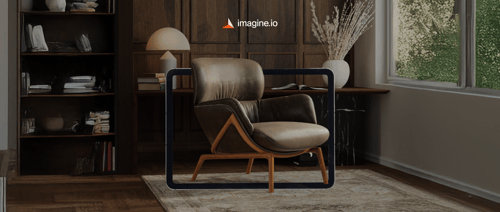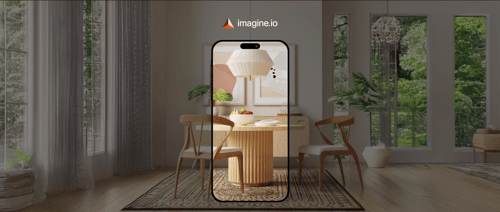Quick Listen:
Product visualization has evolved far beyond static images or cumbersome prototypes. Envision a virtual showroom where you can rotate a 3D model of a luxury watch, customize its strap, and use augmented reality to see it on your wrist all within one intuitive platform. This is no futuristic fantasy; it's the transformative reality delivered by platforms like imagine.io, which seamlessly blend video, augmented reality (AR), and 3D tools. As consumer demands escalate and industries strive for innovation, this integrated approach is reshaping how businesses design, market, and sell their products, setting a new standard for engagement and efficiency.
The market for such technologies is booming. A report from Global Growth Insights forecasts the 3D product visualization market to surge from $435.91 million in 2025 to $2.95 billion by 2033, driven by a robust 27.02% compound annual growth rate. Similarly, PS Market Research projects the AR and VR market to reach $200.87 billion by 2030, with a 22% growth rate. These figures underscore a clear trend: businesses are clamoring for tools that don't merely display products but bring them to life in vivid, interactive ways.
The Strength of Unified Technology
Why is this integration so pivotal? Consider a home decor retailer. A decade ago, shoppers relied on flat catalog images, guessing whether a lamp would suit their space. Now, platforms like imagine.io empower customers to explore a 3D model, adjust its finish, and use AR to place it in their room all without stepping foot in a store. This isn't a novelty; it's a paradigm shift. The Global Growth Insights report notes that 3D visualization tools increase e-commerce engagement by 65% and enable 78% of users to make quicker purchase decisions, transforming hesitation into action.
The power lies in the synergy of these technologies. Video delivers compelling narratives, showcasing products in dynamic contexts. Augmented reality, as described on Wikipedia, overlays digital elements onto the physical world, enriching sensory experiences through visuals, sound, or touch. 3D tools, meanwhile, offer granular control, allowing real-time manipulation of product details. Individually, each is formidable; combined, they create a cohesive platform that streamlines design, prototyping, and marketing with remarkable precision.
Transformative Applications
In retail, integrated platforms address a long-standing pain point: the inability to touch or try products online. A shopper eyeing a pair of headphones can watch a video highlighting their features, rotate a 3D model to inspect the build, and use AR to visualize them on their desk. Snap, the parent company of Snapchat, is banking on this future. The Times reported that Snap's CEO, Evan Spiegel, introduced their AR glasses, “Specs,” slated for 2026. Spiegel envisions a world where consumers break free from the “small 2D rectangle” of smartphones, experiencing products in “three-dimensional splendor” that feels immersive and intuitive.
Manufacturing also reaps significant benefits. Traditional prototyping, with its high costs and lengthy feedback cycles, is giving way to interactive 3D models that teams can test and refine in virtual environments within hours. The PS Market Research report highlights how these efficiencies are fueling the AR and VR market's growth. In automotive design, engineers simulate vehicle aesthetics and functionality, while real estate professionals craft virtual tours that blend video walkthroughs with AR overlays of potential renovations, offering clients a glimpse of their dream home.
Education, too, is transformed. Students can dissect a 3D model of a historical artifact, watch a video explaining its significance, and project it into their classroom via AR. These tools don't just educate they inspire, making learning an immersive journey.
Navigating the Obstacles
Yet, the path to integration is fraught with challenges. Merging video, AR, and 3D tools demands technical prowess, as disparate systems must work in harmony. Compatibility issues and high computational requirements can strain resources, particularly for smaller firms. Cost is another barrier. A study on ArXiv emphasizes that adopting AR and VR technologies involves substantial investment, not only in infrastructure but also in addressing privacy and security risks, such as data vulnerabilities in immersive environments.
User adoption poses a further challenge. Non-technical employees may find these platforms intimidating, necessitating robust training programs. Intuitive interfaces are critical to prevent alienation, yet designing them is no small feat. For budget-conscious companies, the upfront costs can seem daunting, raising the question: will the benefits justify the investment? The answer hinges on execution and strategic implementation.
Unlocking Opportunities
The evidence suggests they do. Platforms like imagine.io don't merely solve problems they open doors. For consumers, the experience is richer and more tailored. A 3D model that lets you customize a jacket's color, paired with an AR view of it in your wardrobe, transforms shopping into an engaging event. The Global Growth Insights report reveals that 52% of businesses adopting these tools report higher customer satisfaction, a testament to their impact.
Businesses, meanwhile, gain operational advantages. Virtual prototypes reduce production costs and accelerate time-to-market, while streamlined design processes enhance agility. Marketing campaigns also evolve. Picture an advertisement where customers interact with a 3D product through AR, guided by a polished video narrative. Such campaigns don't just sell they resonate, boosting conversion rates and brand loyalty.
The Road Ahead
What lies on the horizon? Industry experts foresee AI amplifying these platforms, automating customization and anticipating consumer needs. A Grand View Research report projects the AI video generator market to hit $1.96 billion by 2030, signaling a convergence of AI with visualization technologies. AR glasses, like Snap's Specs or Meta's upcoming designs, promise to untether these experiences from screens, offering seamless immersion.
The shift, however, is more than technological it's cultural. As Spiegel articulated, we're moving from staring at devices to engaging with the world. Platforms like imagine.io are at the forefront, crafting experiences that feel less transactional and more experiential. For businesses, the strategy is straightforward: start modestly. Pilot a single product on an integrated platform, quantify the results, and scale strategically. Cross-functional collaboration spanning design, marketing, and IT will be essential to maximize impact.
In a decade, shopping without 3D visualization or AR may feel as antiquated as flipping through a mail-order catalog. Today, the transformation is in motion, driven by platforms that unify video, AR, and 3D tools into a single, powerful dashboard. The data is compelling, and the experience is exhilarating. This is the future of product visualization bold, immersive, and unmistakably here.
Disclaimer: The above helpful resources content contains personal opinions and experiences. The information provided is for general knowledge and does not constitute professional advice.
You may also be interested in: 3D Lifestyle Imagery – imagine.io
Struggling with expensive, outdated product visuals that slow down your creative process and stunt eCommerce growth? imagine.io's AI-powered platform empowers furniture, home décor, and textile brands to effortlessly produce striking 3D images, immersive videos, AR experiences, and interactive configurators. Cut production costs up to 70%, boost conversions 5X, speed up prototyping, and supercharge your online sales. Ready to elevate your product visuals and captivate customers? Book a demo with imagine.io today!
Powered by flareAI.co




.png?width=500&name=How%20to%20Add%20a%203D%20Product%20Configurator%20to%20Your%20WordPress%20Website%20(Complete%20B2B%20Guide).png)
















%20(1).png?width=500&name=Why%20Exploded%20Mattress%20Views%20Matter%20(And%20How%20to%20Generate%20Them)%20(1).png)
.png?width=500&name=Best%20Shopify%20Product%20Configurator_%20How%20to%20Choose%20the%20Right%20One%20(2).png)
.png?width=500&name=Why%20Exploded%20Mattress%20Views%20Matter%20(And%20How%20to%20Generate%20Them).png)



.png?width=500&name=Best%20Shopify%20Product%20Configurator_%20How%20to%20Choose%20the%20Right%20One%20(1).png)







.png?width=500&name=How%203D%20Rendering%20Can%20Make%20or%20Break%20Your%20Industrial%20Design%20Pitch%20(1).png)








%20with%20Digital%20Twins%20and%203D%20Visualization.png?width=500&name=Optimizing%20Your%20Digital%20Asset%20Management%20(DAM)%20with%20Digital%20Twins%20and%203D%20Visualization.png)




.png?width=500&name=Styling%20Home%20Decor%20for%202025_%20From%20Global%20Influences%20to%20Playful%20Personalization%20(1).png)
